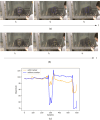Estimating the cardiac signals of chimpanzees using a digital camera: validation and application of a novel non-invasive method for primate research
- PMID: 37249898
- PMCID: PMC10991041
- DOI: 10.3758/s13428-023-02136-y
Estimating the cardiac signals of chimpanzees using a digital camera: validation and application of a novel non-invasive method for primate research
Abstract
Cardiac measures such as heart rate measurements are important indicators of both physiological and psychological states. However, despite their extraordinary potential, their use is restricted in comparative psychology because traditionally cardiac measures involved the attachment of sensors to the participant's body, which, in the case of undomesticated animals such as nonhuman primates, is usually only possible during anesthesia or after extensive training. Here, we validate and apply a camera-based system that enables contact-free detection of animals' heart rates. The system automatically detects and estimates the cardiac signals from cyclic change in the hue of the facial area of a chimpanzee. In Study 1, we recorded the heart rate of chimpanzees using the new technology, while simultaneously measuring heart rate using classic PPG (photoplethysmography) finger sensors. We found that both methods were in good agreement. In Study 2, we applied our new method to measure chimpanzees' heart rate in response to seeing different types of video scenes (groupmates in an agonistic interaction, conspecific strangers feeding, nature videos, etc.). Heart rates changed during video presentation, depending on the video content: Agonistic interactions and conspecific strangers feeding lead to accelerated heart rate relative to baseline, indicating increased emotional arousal. Nature videos lead to decelerated heart rate relative to baseline, indicating a relaxing effect or heightened attention caused by these stimuli. Our results show that the new contact-free technology can reliably assess the heart rate of unrestrained chimpanzees, and most likely other primates. Furthermore, our technique opens up new avenues of research within comparative psychology and facilitates the health management of captive individuals.
Keywords: Comparative psychology; Contact-free; Heart rate; Signal processing.
© 2023. The Author(s).
Figures












References
-
- Aiello, S. E. (2016). The Merck veterinary manual (p. 3325). White Station, NJ, USA: Merck & Company, Incorporated.
-
- Al-Naji A, Gibson K, Lee S-H, Chahl J. Monitoring of cardiorespiratory signal: Principles of remote measurements and review of methods. IEEE Access. 2017;5:15776–15790.
Publication types
MeSH terms
LinkOut - more resources
Full Text Sources

